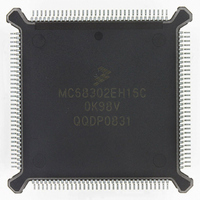MC68302EH16C Freescale Semiconductor, MC68302EH16C Datasheet - Page 109

MC68302EH16C
Manufacturer Part Number
MC68302EH16C
Description
IC MPU MULTI-PROTOCOL 132-PQFP
Manufacturer
Freescale Semiconductor
Datasheets
1.MC68302AG20C.pdf
(4 pages)
2.MC68302AG20C.pdf
(2 pages)
3.MC68302AG20C.pdf
(13 pages)
4.MC68302EH16C.pdf
(481 pages)
Specifications of MC68302EH16C
Processor Type
M683xx 32-Bit
Speed
16MHz
Voltage
5V
Mounting Type
Surface Mount
Package / Case
132-MQFP, 132-PQFP
Controller Family/series
68K
Core Size
32 Bit
Ram Memory Size
1152Byte
Cpu Speed
16MHz
No. Of Timers
3
Embedded Interface Type
SCP, TDM
Digital Ic Case Style
PQFP
Rohs Compliant
Yes
Family Name
M68000
Device Core
ColdFire
Device Core Size
32b
Frequency (max)
16MHz
Instruction Set Architecture
RISC
Supply Voltage 1 (typ)
5V
Operating Temp Range
0C to 70C
Operating Temperature Classification
Commercial
Mounting
Surface Mount
Pin Count
132
Package Type
PQFP
Lead Free Status / RoHS Status
Lead free / RoHS Compliant
Features
-
Lead Free Status / Rohs Status
RoHS Compliant part
Electrostatic Device
Available stocks
Company
Part Number
Manufacturer
Quantity
Price
Company:
Part Number:
MC68302EH16C
Manufacturer:
Freescale Semiconductor
Quantity:
135
Company:
Part Number:
MC68302EH16C
Manufacturer:
PANA
Quantity:
99
Company:
Part Number:
MC68302EH16C
Manufacturer:
Freescale Semiconductor
Quantity:
10 000
Part Number:
MC68302EH16C
Manufacturer:
FREESCALE
Quantity:
20 000
Company:
Part Number:
MC68302EH16CB1
Manufacturer:
Freescale Semiconductor
Quantity:
10 000
Company:
Part Number:
MC68302EH16CR2
Manufacturer:
Freescale Semiconductor
Quantity:
10 000
- MC68302AG20C PDF datasheet
- MC68302AG20C PDF datasheet #2
- MC68302AG20C PDF datasheet #3
- MC68302EH16C PDF datasheet #4
- Current page: 109 of 481
- Download datasheet (2Mb)
When an external master desires to gain ownership, the standard M68000 bus arbitration
protocol should be used:
This protocol is also followed by the on-chip bus masters (IDMA, SDMA, and DRAM refresh)
except that they request the bus internally from the on-chip bus arbiter.
In the disable CPU mode, the IMP makes requests for the bus rather than granting the bus.
In such a system, the IMP functions as an external master, and the external processor (e.g.,
an MC68030) need not assert BGACK as it accesses the IMP's on-chip RAM and registers.
3.8.6 Hardware Watchdog
The hardware watchdog logic is used to assert BERR and set HWT when a bus cycle is not
terminated by DTACK and after a programmable number of clock cycles has elapsed. The
hardware watchdog logic has a 10-bit downcounter and a 4-bit prescaler. When enabled,
the watchdog timer commences counting clock cycles as AS is asserted (for internal or ex-
ternal bus masters). The count is terminated normally by the negation of AS; however, if the
count reaches zero before AS is negated, BERR will be asserted until AS is negated. The
hardware watchdog will operate with internal as well as external bus masters.
The hardware watchdog logic uses four bits in the SCR.
HWDEN—Hardware Watchdog Enable
MOTOROLA
1. Issue BR (to the IMP on-chip bus arbiter).
2. Wait for BG (from the IMP on-chip bus arbiter).
3. When BG is asserted, wait for the negation of both AS and BGACK.
4. Assert BGACK and begin external master bus cycles.
5. Negate BR (to the IMP on-chip bus arbiter), causing BG to be negated
6. Negate BGACK after the external master bus cycles have completed.
After system reset, this bit defaults to one to enable the hardware watchdog.
0 = The hardware watchdog is disabled.
1 = The hardware watchdog is enabled.
by the IMP on-chip bus arbiter.
When the IMP's BUSW pin is low causing the M68000 core to
operate as an MC68008, the BGACK signal should still be used
in bus arbitration control. On the original MC68008, the BGACK
signal was not available externally, and therefore could not be
used.
MC68302 USER’S MANUAL
NOTE
System Integration Block (SIB)
3-59
Related parts for MC68302EH16C
Image
Part Number
Description
Manufacturer
Datasheet
Request
R
Part Number:
Description:
Manufacturer:
Freescale Semiconductor, Inc
Datasheet:

Part Number:
Description:
MC68302 Configuring the Chip Selects on the MC68302
Manufacturer:
Motorola / Freescale Semiconductor

Part Number:
Description:
MC68302 Design Concept - Expanding Interrupts on the MC68302
Manufacturer:
Motorola / Freescale Semiconductor

Part Number:
Description:
MC68302 MC68302 Adapting a WAN Controller to a LAN Environment
Manufacturer:
Motorola / Freescale Semiconductor

Part Number:
Description:
MC68302 EKB Applications - Power Measurements on the MC68302
Manufacturer:
Motorola / Freescale Semiconductor

Part Number:
Description:
MC68302 Interfacing the MC68020 to a Slave MC68302
Manufacturer:
Motorola / Freescale Semiconductor

Part Number:
Description:
MC68302 MC68302 Software Performance
Manufacturer:
Motorola / Freescale Semiconductor

Part Number:
Description:
MC68302 Evaluating EDX on the ADS302
Manufacturer:
Motorola / Freescale Semiconductor

Part Number:
Description:
MC68302 Design Advisory #1 - MC68SC302 Passive ISDN Protocol Engine
Manufacturer:
Motorola / Freescale Semiconductor

Part Number:
Description:
MC68302, MC68360, and MPC860 Characteristics and Design Notes for Crystal Feedback Oscillators
Manufacturer:
Motorola / Freescale Semiconductor
Part Number:
Description:
Mc68302 Integrated Multi-protocol Processor
Manufacturer:
Freescale Semiconductor, Inc
Datasheet:
Part Number:
Description:
Manufacturer:
Freescale Semiconductor, Inc
Datasheet:
Part Number:
Description:
Manufacturer:
Freescale Semiconductor, Inc
Datasheet:
Part Number:
Description:
Manufacturer:
Freescale Semiconductor, Inc
Datasheet:
Part Number:
Description:
Manufacturer:
Freescale Semiconductor, Inc
Datasheet:











